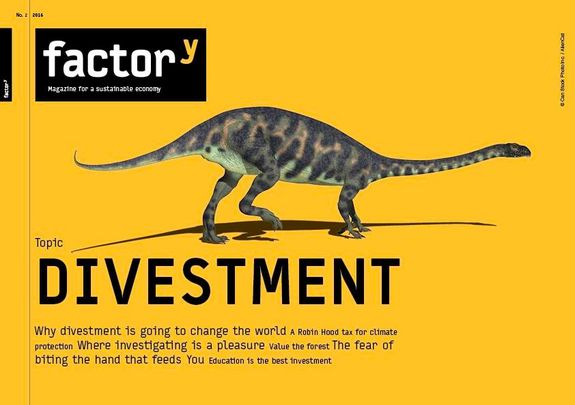Divestment

Turning away from coal and oil towards sustainability. Whether it is infrastructure projects, sustainable funds, regional plans, energy and housing cooperatives, citizen co-operations or microfinance, financial investments of various asset classes can be of direct use in many ways and provide both major and private investors with a return on their investment. Shares are for those who are prepared to take risks and want to see what happens with their money.
By Susanne Bergius
Translated from the German by: Kathrin Ellwanger, Anneka Faiß, Eliot Reiniger, Ella Dering, Birgit Bernhardt, Kathryn Batchelor, James Knight, Bianca Bauer, Evie Quinlan, Tamara Reiser, Marco Hoffmann, Nadine Feuchter and Katrin Haßberg.
‘Stranded assets’ – this term is currently shaking the financial markets worldwide. Investors fear ‘stranded’ capital, meaning assets that drastically diminish as a result of a decline in value of industries based on fossil energies.
For example, in 2015 a report for the Swiss Federal Office for the Environment (FOEN) revealed that the equity funds of Switzerland finance 52 million tonnes of CO2 equivalents – that is the same amount as the country’s greenhouse gas emissions in 2013. It states that this could cost the market up to CHF 6.75bn: “If pension funds had to bear their CO2 costs, this would correspond to approximately one fifth of the old-age pension currently paid out each year when considering the highest price scenario.”
For such reasons, pension funds, insurances, foundations and church institutions around the world reject CO2-intensive capital investments such as shares in oil or coal companies.
2000 private individuals also belong to this divestment movement. Together they represent capital of approximately USD 3.4trn in total; that capital is supposed be fossil-free.
But how should the money be invested? With such large sums, it is not that easy. Wholesale investors are desperately looking for opportunities, and they exist, but mostly in areas where investing is not just gratifying for investors but also profitable in the long-term and useful at the same time. They are useful because they can regionally, nationally and globally stimulate sustainable lifestyles and economic styles. There is a wide variety of investment opportunities available for both institutional and private investors. Wholesale investors place their funds in infrastructure projects involving energy and water supplies, even in places where people have no electricity or clean drinking water.
Green bonds are especially in demand; green bonds attracted USD 41.8bn last year, which is a record according to the British Climate Bonds Initiative (CBI). In 2016, the volume of Green Bond sales is expected to double. Green bonds are interest-bearing securities which are issued by states or companies and the issuing of which finances projects to help the environment and to contribute to the mitigation of climate change. Social bonds fund social projects. This is a niche market but billions of dollars are currently placed with wholesale investors in the form of social bonds. In light of some skepticism about whether the bonds deliver what they promise, Moody’s, the US rating agency, has developed a procedure to assess these bonds. Prior to that, investors had adopted the Green Bond Principles in 2014. In addition, the CBI has developed the Green Bond Standard. According to the World Bank, which claims to have issued one hundred green bonds by mid-2015 to the tuen of over USD 8.4bn for 77 green projects, has also issued statements regarding their impact.
Investors are more often increasingly oriented towards the real world economic effects of their investments. In addition to investment returns, they want to see a measurable social or ecological benefit. According to the Bertelsmann foundation, German investors spent EUR 70m on such financial products in 2015 – that is three times more than in 2012. These funds serve social businesses and promote employment, education, health and sustainable consumption. The capital mostly comes from wealthy people or foundations. Two BMW foundations and the Bertelsmann foundation intend to expand their impact-oriented investments of ten million dollars over the medium term.
The local market is still small, but the potential is enormous: the so-called impact investments are managing roughly USD 13.3bn – and the trend is rising according to the non-profit US organization Impact Assets.
The dimensions of crowd investing are much smaller. Last year, clean energies attracted swarm financing of EUR 6.9m in Germany; many small investors support local projects. In February, the information platform crowdfunding.de determined that investments in green energy projects have increased by 167 percent, meaning that they now represent 14 percent of the overall swarm-investing market.
Those purchasing shares of retail funds which encourage the economical use of energy can contribute to the energy revolution. The political aim is to reduce the energy consumption in every field by up to 80 percent until 2050. To make this possible, innovations and extensive investments are necessary.
Some of the public funds take energy efficiency into account. The Swiss Vontobel Fund Global Clean Technology explains that clean and efficient production processes lead to the reduction of energy and material consumption while simultaneously increasing productivity. With the Global Equity Climate Change Fund, the HSBC Global Investment Funds group (GIF) invests at least two thirds of its total assets (EUR 12m) into shares and stocks of companies which tackle the problem of energy and water wasting.
Other investments devoted to energy change, are closed-end funds and profit participation rights. The group 7x7 Bürgerenergie I. GmbH & Co. KG serves as an example of direct investments for German photovoltaic plants. Investors can start with a minimum amount of EUR 5,000. However, given that the funds have a duration until at least the end of 2025, the yield forecast of 4.6 % per year remains uncertain. In an analysis, the magazine ECOreporter warns that the running costs associated with the operation of solar plants are tightly calculated and therefore, unforeseeable cost increases are likely and can reduce the investors’ yields. Although direct investments entail high chances of yields, they also pose the risk of total loss.
In contrast, retail funds are special investment funds which continue to exist even if the provider goes bankrupt. However, they are not without risk, especially when they include shares. Many energy retail funds collapsed during the financial crisis. Some of them have not yet recovered, while others have surpassed their previous all-time highs. Technology fund rates are volatile and stock market prices fluctuate significantly, whether they are ‘eco’ funds or not.
Investors should consider diversification of risk. Specialised funds and direct shares should only be added to other investments and it is necessary to think long term and be patient. However, it can also be encouraging to see how one of your co-financed projects is developing on site.
In comparison, another option which is safer but still not without risk, is loans. Examples include loans for climate projects, i.e. for local wind energy projects as offered by some savings banks or people’s and cooperative banks. Although yields are hardly more than 1 % annually, they surpass the current level of interest rates.
Sustainable reforestation projects which promote climate protection are also becoming more popular. The German Forest Finance Group in Bonn offers various forms of such investment projects. However, forestry is incomparable with other asset classes as investments are invested directly into the soil and forest. This requires patience from investors because forests grow slowly. In addition, investors need to research the projects carefully: some climate compensation projects are cultivating fast-growing monocultures in the global South that are destroying ecologically and economically efficient local systems (see factory magazine Divestment page 32).
Investors can also promote sustainable economy, an indirect effect of investing in sustainable retail funds in many different sectors. At the turn of the year, the 400 existing funds in the German-speaking world added up to EUR 45bn. In many cases, there are large institutional tranches for foundations or church institutions which means that the actual total is much higher. Funds are inevitably rather abstract in deposit accounts and their effects are not always immediately visible. Since autumn 2015, the Forum Nachhaltige Geldanlagen (FNG) (Forum on Sustainable Investments) label has provided orientation just as the FNG fund profiles have done for a few years now.
Direct eco-social effects can be achieved through very different forms of investment, such as microfinancing, so called Bürger AGs (citizen PLC’s) or cooperatives.
Microfinancing is a custom-made concept for the poorest people who cannot get any loans from normal banks for foundations, business expansions or investments. Microfinance institutions, however, can offer them loans when dealing with small sums of money. In 2006, Muhammad Yunus from Bangladesh, founder of the microfinance bank Grameen, received the Nobel Peace Prize for this creation. Meanwhile, helping people to self-help can be promoted through specific investments such as funds, savings products or a cooperative.
Specialised microfinance products cannot usually be sold every day, but in view of stagnating interest rates the returns are attractive and constant, since microfinancing is not dependent on the stock market price. The fluctuation margin in performance is smaller. The risk is lower, because it is divided into countless loans. Experts say that repayment rates are high and that on average only two percent of loans are not paid back. Michael Sommer from Bank im Bistum Essen (Bank in the diocese of Essen) says that when done professionally and seriously, microfinance is a useful device for fighting poverty. The bank has years of experience in two institutional funds and the new so-called KCD-Mikrofinanzfonds III (KCD Microfinance Fund III – a microfinance investment vehicle) for private investors. The fund Invest in Visions IIV has been available for private investors for a longer amount of time.
For experienced investors and foundations, the GLS Bank in Bochum, together with other institutions, placed bonds of an international microfinance vehicle in the sum of USD 37m in 2014. That is enough for 10,300 microloans. GLS is also offering an ‘Oikocredit’ account. Oikocredit is a Dutch cooperative and one of the world’s largest microfinancers. For years, investors have been receiving two percent interest per year for the shares, which can be bought for as little as a couple of hundred euros. German sponsor associations already have more than 23,500 members. CEO for Germany, Matthias Lehnert, says that they have invested EUR 389m in Germany which is 14.5 percent more than in the previous year. The money goes to people in developing and newly industrialised countries, especially to women who support themselves and their families through their self-employment. It is estimated that 37 million people are reached through microfinance partners.
There is also criticism against microfinancing and its impact on supporting the poorest people. For more information, see the list of pros and cons on the tab Participation on factory-magazin.de or in the factory magazine Partaking.
Cooperatives also deal with other sectors. This type of business organisation is reaching new heights: there are approximately 7,600 cooperatives in Germany, with about 20 million members. They are mostly active in the finance sector and in real estate, and increasingly also in power generation and agriculture. People often form alliances to help each other.
Cooperatives increasingly attract members for sustainable projects when they offer returns. Maro Genossenschaft für selbstbestimmtes und nachbarschaftliches Wohnen eG (MARO Cooperative for Independent and Neighbourhood Living) relies on small and wealthy investors. They support citizens and municipalities by building barrier-free multi-generational community living schemes in southern Germany. Prospective return: four percent.
Some cooperatives oblige investors to pay additional contributions in a crisis situation, but, according to consultants, they are fundamentally suitable for defensive investors who want to invest money on a long-term basis. Cooperatives are one of the safest types of business: according to the Creditreform Group, less than one percent become insolvent. Therefore, midway through 2015, 38,000 shareholders turned the wind farm construction company Prokon, which had once been insolvent, into a cooperative. Thousands of investors had lost a lot of money in the course of the former direct investment.
Bürger-AGs are set up differently. These new companies want to promote regions by investing in the real economy: as local public limited companies, they do not only pursue monetary objectives but also social, ethical, regional, cultural or ecological ones. It is thus easier to raise capital for new projects and economically underdeveloped regions or in cases where banks refuse to grant loans. According to experts, investment is possible without any large contributions and major formalities.
For instance, the Zwergenküche in Endingen, founded in 2012, provides regional, organic meals for kindergarten children. The Freiburg-based Regionalwert AG (Regional Value PLC) contributed to the investments. Its network consists of 16 farms, food producers, trading companies and service providers. Further Regionalwert AGs have now been set up in other places. 230 local citizens and organizations have a stake in the Hamburg-based Regionalwert AG after a second share issue in early March, according to its board of directors.
In 2010, Nestbau (Nest Building), the first Bürger-AG for rental flats, was founded in Tübingen. It constructed a socioecological building for residential and commercial purposes. Tenants have moved into it since 2014, among them single parents with children and a youth residential community. Flexible office workstations are provided in this building in the city’s first co-working space, on a daily, weekly or monthly basis. Nestbau connects people looking for affordable living and working space close to the city centre with sustainable investors. According to its founder, Gunnar Laufer-Stark, shareholders from all over Germany invested between EUR 1,000 and EUR 50,000 each.
In their first years, however, start-ups often post losses since it takes time to invest in projects and companies. Investors should thus hedge their bets and be well-informed before taking any decisions. Bürger-AGs are suitable for people who are aware of the risk and, as joint owners, want to see what happens to their money.
A different understanding of return. Many local and regional ‘forms of investment’ have a different understanding of return from traditional ones. In Nestbau’s view, the return should be generated from the monetary return (the dividend) and the socioecological contribution. The Bürger AG FrankfurtRheinMain, which invests in a social organic industry, assumes initial returns on investment of approximately 1.0 to 2.5 percent since they do not operate according to the principle of profit maximization, but according to criteria of a sustainable, socioecological economy.
The Freiburg-based Regionalwert AG wants to produce profits from leases, investments and services, as well as generating socioecological profits. The 2015 ‘socioecological annual report’ explains performance with regard to 13 indicators in both a quantitative and a qualitative manner: these indicators include employment trend, soil quality and regional added value.
Christian Hiss, founder of the Regionalwert AG: “Only the financial operating profit in combination with social-ecological development shows whether or not the capital has been used for sustainable management.” The overall success of this approach is described in the Factory Magazine Partaking and Taking Part. Investors have to decide if they share a common understanding of returns. Various investment vehicles open up the possibility of contributing in the long-term to sustainable development, although a specific financial return is required.
Susanne Bergius is a journalist and moderator for sustainable management and investment. She is a regular contributor to the German newspaper Handelsblatt Business Briefing Nachhaltige Investments and co-publisher of the book CSR und Finance. Recently, she published the article ‘No change without risk!’ in the Factory Magazine ‘Crime and Punishment’. Susanne Bergius is the co-founder and chief executive officer of the non-profit organisation Netzwerk Weitblick – Verband Journalismus & Nachhaltigkeit e.V.
More articles to the topic of divestment, to stranded assets and to investments in renewable energies, in sustainable economy and in education there are not only online but in the factory magazine Divestment, which is ready to download. It is finely illustrated and good readable on tablets and screens and it contains all articles and pictures and even additional numbers and citations.
Themen
- The Domino Effect: the Mobility Transition as an Engine for the ‘Great Transformation’
- Cities Use the Space
- Decarbonization by 2030
- The fear of biting the hand that feeds you
- Where investing is a pleasure
- Why divestment is going to change the world
- A Robin Hood tax for climate protection
- May the Force Be with Us
- Modern Strategies
- The prerogative of interpreting the future now lies with the companies involved in climate protection”
- From Negotiating to Trading Equitably
- Can a donkey be tragic?
- Rethink rather than rebound: a sufficiency revolution must precede the efficiency revolution
- On Rebound, Prebound and Performance Gaps
- So Let Us Seize Power Then!
- With Common Property Against Political Failure
- So Let Us Seize Power Then!
- The Comforting Beauty of Failure
- “It Is Not Impossible at All.“
- Resource-light shopping
- Men Have Not Stopped Giving the Advantage to Women – So Far
- Toothpaste for Princesses and Soup for Pirates
- It is about equality
- A nice day
- Initiative instead of frustration
- The right ingredients
- Resilient for Life
- Not only, but also
- Appreciation – more please!
- Worth more than money
- Learning to value the value of goods
- Worth and Values
- The Transformative Power of Science
- Historically effective: How innovation and technology transform
- The Disappearance of Products
- Growing Older 101
- Columbus’ Egg
- It Works! In Theory at Least ...
- What If...?
- Analysing Separately – Thinking and Acting Together!
- Let’s Break Away from Determined Breaking Points
- More Gold in Waste than in Mines
- The art of separation
- Should you really DIY?
- The Aesthetics of Do-It-Yourself
- Standing on One’s Own Feet
- From the handaxe to desktop fabrication
- Using Shares to Survive the Crisis
- When Citizens participate
- Possess to Participate
- The Right Growth at the Right Time
- Gunter Pauli and Blue Economy
- When Sustainability Grows
- How we treat Growth
- Illusions about Growth


